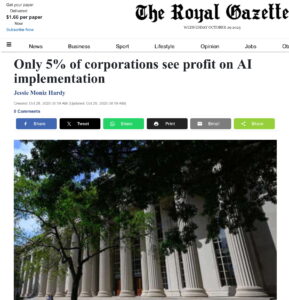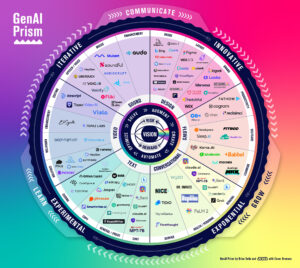
MarketingProfs recently published a fantastic report on the equality of B2B and B2C adoption and practice of social media. In “The State of Social Media Marketing,” the 242-page report shared how over 5,000 marketers and business professionals use social media to create award winning campaigns, measure ROI, and reach audiences. Jay Baer offers an interesting analysis at Convince and Convert. More of my thoughts on the subject of B2B and B2C social media are shared in my post, “The Business of Social Media.”
One of the more interesting charts shared was a look at company policy as it relates to social media use during business hours. On average, about 60% of companies polled maintain a “common sense” approach to at-work usage of social media. As MarketingProfs observes however, that an increasing number of companies are banning access to social networks in general.

As Stowe Boyd recently observed:
Management often responds to the adoption of social tools the way that public policy has responded to texting while driving: they make it illegal to be social while working.
The far-sighted response will be to make it easier to gain the benefits of social business, and to rethink the organization and management of work around human nature instead to persisting in trying to ‘rise above’ what makes us people in the first place.
Removing the Blindfold
By all means, you will find the MarketingProfs report interesting. My area of focus, for this post specifically, is on the data shared in two charts specifically. The intent of the graphics was to share the distribution of attention and resources between B2B and B2C organizations across social media channels. The reality is that they also demonstrate a confined view of activity across the entire social web. As a result, most brands concentrate time, energy, and budget on identical social media strategies and tactics…
1. Facebook
2. Twitter
3. LinkedIn
4. YouTube


In 2010, executives will measure ROI and the direct impact of social media marketing on the P&L. In order to do so, management will experience three phases.
The first will reveal that measuring social media marketing, as practiced to date, is essentially meaningless. Documenting the growth of friends, followers, and fans does not represent loyalty or advocacy. Increased pageviews and clickthroughs doesn’t equate to an increase in revenue, improvement of products and services, nor a reduction or elimination of outdated or inefficient processes.
Second, management will grasp the true cost of social media. In 2010, social media will cease to be free. Twitter will offer commercial services, service vendors will offer more sophisticated sCRM (SRM) solutions that will adapt to the new internal infrastructures that will have to be built in order to scale, and there are very real costs associated with human and intellectual capital. Management will have the prowess in 2010 to measure the cost of a tweet and the expected return on targeted engagement.
Third, as the entire organization socializes affected departments, strategists will embrace a holistic and informed approach to engagement. Audits will become standard in 2010, where each team analyzes relevant activity and conversations using the Conversation Prism or similar map as a guide to exploring all social networks and discussion forums. By documenting the frequency, volume, reach, impact, and state over a period of time, brands will amass the intelligence necessary to prioritize networks while also revealing the influential voices within each community.
As a result, social media marketers will shred the cookie-cutter manual and expand the focus based on real world activity. This is social media marketing with a purpose.
You ask who owns Social Media…your customers, prospects, and influencers define your markets, focus, and attention – where and when they congregate and communicate.
Connect with Brian Solis: Twitter, LinkedIn, Tumblr, Plaxo, or Facebook
—

Get the new iPhone app!
—
Click the image below to buy the book/poster:


—
Image Source: Shutterstock





A great post and follow-up to your previous “Social Marketing in 2010”. The section in your previous post regarding the transition from information-gathering to intelligence-gathering as companies mature in the social media sense is dead-on. In fact, we believe it so deeply we're creating a company to meet the needs of companies graduating from friend and fan tracking to true intelligence-gathering.
In the first phase, companies begin to realize the sheer volume and magnitude of relevant data out there in the social space. Initially, they try to define and delineate that data according to easy to track metrics (Direct Metrics). It helps carve a manageable data set from a large ocean of data.
As they grow comfortable with that, they begin to expand their view and monitor ever-increasing volumes of data until finally, they begin to explore the increasingly complex relationships between that data. Here, deep in phase 2, they'll begin to search for more complex and sophisticated tools — more than monitoring, they're looking for “Intelligence Engines”. It's these Intelligence Engines that make Phase 3 truly possible.
Great analysis Brian. Thanks so much for the link to my post about the MarketingProfs study. I completely agree that we're going to have to move well beyond counting friends. But even more so, we have to start calculating the true (labor and opportunity) costs of social media. The biggest problem in the social media ROI equation isn't that we're screwing up the R, it's that we're not acknowledging the I.
Jay, thanks for the comment! Absolutely. The myth that social media is free is no longer a myth. There are hard costs that define the investment and also real opportunities to establish and measure the return on that investment. Keep up the great work!
One of my good friends who runs a web design studio syas that “social media is free – like a puppy is free. Sure, you can get the pup for free but you still have to feed it, walk it and get up to let it out at all hours of the night…” I've always like that analogy.
Great stuff Brian and you as well Jay. The term ROI has become an overused buzz word that makes marketing directors and C-levels look smart and feel good. I like how Shel Holtz approached this is a recent post in that he focuses on established baselines the return comes from moving the needle from there. Personally, I feel like the “I” should be measured in terms of the salaries paid to the operators inside an organization who are operating the tools on behalf of the brand. If “person A” paid “salary X” can use Twitter to tap into customer conversations, trouble shoot, answer questions and route those customers to someone who can address their problem, how much business can be retained? What's that retention worth in dollars and cents? How does that compare to “salary X”. Now what if there are lots of “Salary X” people in an organization?
Am I off base with this?
Yes! Love the puppy comparison, well who doesn't love puppies! Yes, I have a formula that says if X, makes Y and spends Z amount of time in social engaging and producing, then we know the hard cost to it. There's more to the equation as well as engagement comes at the cost of opportunity. What could they be working on and how does that look in the end?
Great post!
I'm from Bulgaria and in my country many people working in banks, big organizations, government and public services have no access to social media at work and many other websites (such as online media, minor search engines, etc.). Social media revolution, though, is very absorbing right now and more and more Bulgarians steal minutes to chat, blog or tweet via their mobile phones or desktop softwares.
I spot some of the reasons for banning of social media sites in the fear that many managers have towards the so-called 'free float of information'. For government employees that is understandable but in the public sector and services that is a great disadvantage. Managers don't understand the essence of social media and lose potential customers and their employee's respect at the same time. That is a major issue we PRs try to solve and discuss here.
helpful as usual. I wonder if it would if it would be in the interest of companies to create formal training programs to help employees set up their own blogs/social networks around specific issues that interest them and then help them to generate good content. anyway i'm sure you've blogged about something like this a hundred times before. Marketingprofs report is a little pricey, think I might go for it though…
I think you're right. Intel provides a digital iq program for this very reason.
Good stuff. In my particular area of interest, the world of publishing, I'm finally beginning to see a willingness at senior management levels to acknowledge the power of the data and the cost of access.
As digital publishing continues its explosive growth, despite Traditional Publishing's best efforts to manipulate the market, a firm grasp of The Social will be critical to managing what will logically be the primary channel of communication and commerce.
Book sales at the big box, brick and mortar retailers already represents The Head to a painfully homogenized degree, so the opportunity for mid-list and debut authors to find their pockets of love in the Long Tail through the prism of online data is shining like a light bulb over [some of] the heads of the publishing world.
Nice post. I'm the author of the report and the Research Director for MarketingProfs. I love these three lines: “measuring social media marketing, as practiced to date, is essentially meaningless”, “as the entire organization socializes affected departments, strategists will embrace a holistic and informed approach to engagement”, and “This is social media marketing with a purpose.” When you look at the data in the report on what tactics are working, those that drive eduction, discourse, and digital bonding tend to work a lot better. When you look at correlations between corporate culture and social media success, two that really popped were “maintaining open honest dialogue about marketing success and failure” and “encouraging collaboration between different departments like IT, marketing, and finance.” In other words, cross-functional teams that allow everybody to be a little bit marketer, and in doing so, give the consumer something more meaty to digest, may be the future of marketing. Once you get these very human bonds formed between buyer and seller, it's hard to go back to banal interruption advertising. This is going to take some getting used to.
Tim, thank you so much. I wholeheartedly agree…
Perhaps we can have a discussion before your next report goes into effect or prior to its release?
Absolutely. I'm always looking for input from the experts prior to going to field with research.
If MarketingProfs itself did not use Twitter or Facebook, to single out two sites, would the metrics be as high among those surveyed? Just wondering.
Not totally sure where this is going, but as the MarketingProfs Research Director, I feel like I ought to hypothesize… Does MarketingProfs use of/advocacy of marketing via Facebook and Twitter get other marketers to do the same? If so, does this mean we are unintentionally affecting the usage numbers we report on? The answer is probably yes to both. However, that usage is reality. We report on the reality that is, not the reality that might have been in a vacuum. Does this invalidate the research? Not at all. We didn't start the fire, we just threw a log on. More important than usage metrics is effectiveness metrics. Among those that use these tactics, do they work? The answer we heard back was a resounding yes. We definitely had nothing to do with that.
Great post Brian, I like the three phases you identified in the last section of the blog.
I think if we all honest we all went for quantity of followers over quality. Its natural but when you dont know where to start, where to get best results etc.
But the shotgun model leads to identifying where to focus, through the cost effectiveness analysis (you identified as stage two) and then the subsequent priority (phase three).
So I agree with what you have written I think it is quite incisive – great post
Cam, indeed. Cheers!
Social Media marketing with a purpose! Engaging instead of measuring the value of your clients, if you don't have time for social media, make time, if you can't make time, then perhaps you need to change your strategy.. “Who owns Social Media…your customers, prospects, and influencers define your markets, focus, and attention – where and when they congregate and communicate.”
Hats of to this analytical & informative post. The graphs & the charts you have used is really good & helpful. It give me a clear conception on the total social network usage by 2009. Again I'll appreciate it. And it is more or less clear that social networking will get a new height in 2010.
The latest gucci collection uses a lot of gold, brown and silver in their designs. Their trademark “G” logo, most popular in gucci womens shoes, is easily one of the most recognizable logos in the world. http://www.gucciwell.com
Great analysis Brian. Thanks so much for the link to my post about the MarketingProfs study. I completely agree that we're going to have to move well beyond counting friends. But even more so, we have to start calculating the true (labor and opportunity) costs of social media. The biggest problem in the social media ROI equation isn't that we're screwing up the R, it's that we're not acknowledging the I.